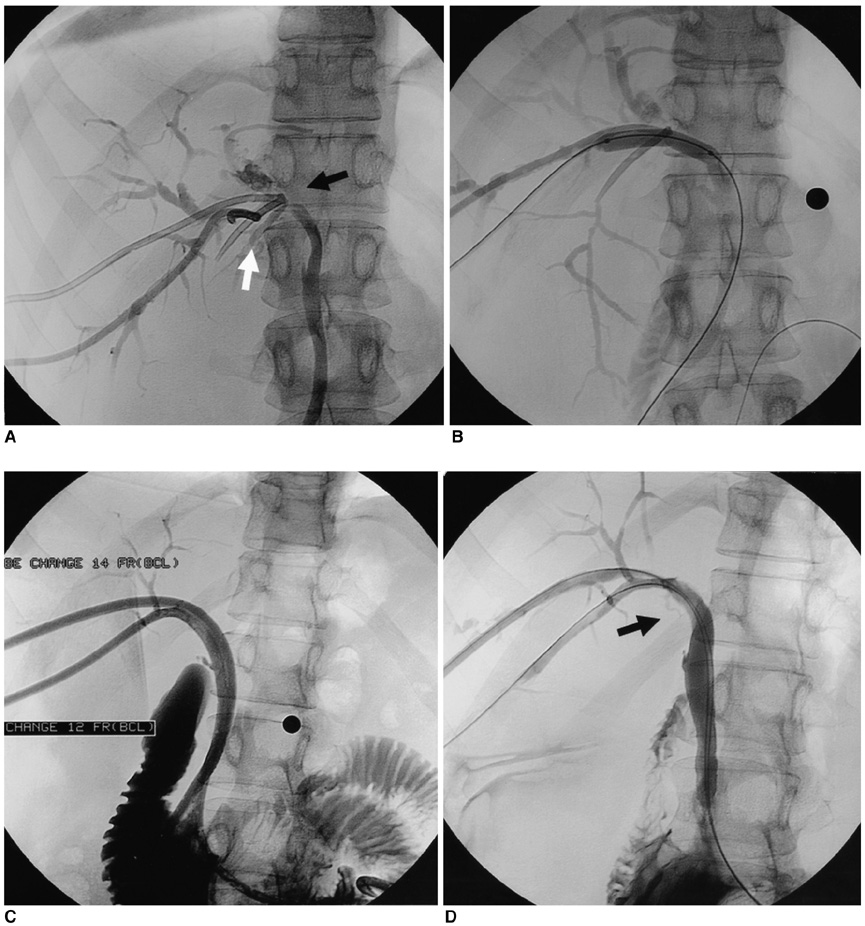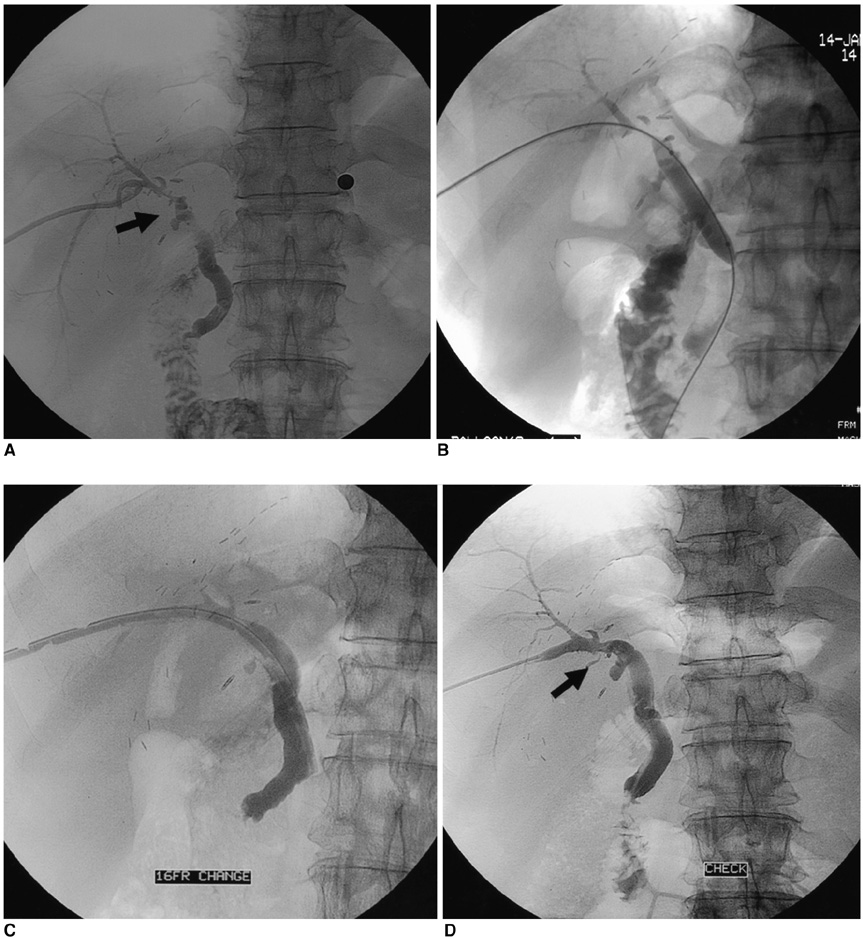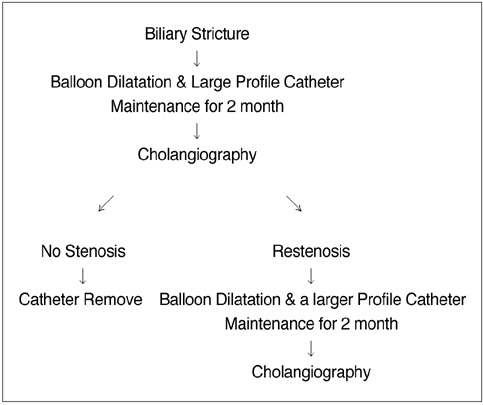Korean J Radiol.
2006 Mar;7(1):41-49. 10.3348/kjr.2006.7.1.41.
The Balloon Dilatation and Large Profile Catheter Maintenance Method for the Management of the Bile Duct Stricture Following Liver Transplantation
- Affiliations
-
- 1Department of Radiology and Center for Imaging Science, Samsung Medical Center, Sungkyunkwan University School of Medicine, Seoul, Korea. swshin @smc.samsung.co.kr
- 2Department of Radiology, Sung-Ae General Hospital, Seoul, Korea.
- KMID: 753915
- DOI: http://doi.org/10.3348/kjr.2006.7.1.41
Abstract
OBJECTIVE
We wanted to evaluate the therapeutic efficacy of the percutaneous balloon dilatation and large profile catheter maintenance method for the management of patients with anastomotic biliary strictures following liver transplant. MATERIALS AND METHODS: From May 1999 to June 2003, 12 patients with symptomatic benign biliary stricture complicated by liver transplantation were treated with the percutaneous balloon dilatation and large profile catheter maintenance method (1-6 months). The patients were eight males and four females, and their ages ranged from 20 to 62 years (mean age: 44 years). Ten patients underwent living donor liver transplantation and two underwent cadaveric liver transplantation. Postoperative biliary strictures occurred from two to 21 months (mean age: 18 months) after liver transplantation. RESULTS: The initial technical success rate was 92%. Patency of the bile duct was preserved for eight to 40 months (mean period: 19 months) in 10 of 12 (84%) patients. When reviewing two patients (17%), secondary balloon dilatations were needed for treating the delayed recurrence of biliary stricture. In one patient, no recurrent stenosis was seen during the further 10 months follow-up after secondary balloon dilatation. Another patient did not response to secondary balloon dilatation, and he was treated by surgery. Eleven of 12 patients (92%) showed good biliary patency for 8-40 months (mean period: 19 months) of follow-up. CONCLUSION: The percutaneous balloon dilatation and large profile catheter maintenance method is an effective therapeutic alternative for the treatment of most biliary strictures that complicate liver transplantation. It has a high success rate and it should be considered before surgery.
Keyword
MeSH Terms
Figure
Cited by 1 articles
-
An Update on Endoscopic Management of Post-Liver Transplant Biliary Complications
Hyun Woo Lee, Najmul Hassan Shah, Sung Koo Lee
Clin Endosc. 2017;50(5):451-463. doi: 10.5946/ce.2016.139.
Reference
-
1. Stratta RJ, Wood RP, Langnas AN, Hollins RR, Bruder KJ, Donovan JP, et al. Diagnosis and treatment of biliary tract complications after orthotopic liver transplantation. Surgery. 1989. 106:675–683.2. Rabkin JM, Orloff SL, Reed MH, Wheeler LJ, Corless CL, Benner KG, et al. Biliary tract complications of side-to-side without T tube versus end-to-end with or without T tube choledochocholedochostomy in liver transplant recipients. Transplantation. 1998. 65:193–199.3. Thethy S, Thomson B, Pleass H, Wigmore SJ, Madhavan K, Akyol M, et al. Management of biliary tract complications after orthotopic liver transplantation. Clin Transplant. 2004. 18:647–653.4. Gholson CF, Zibari G, McDonald JC. Endoscopic diagnosis and management of biliary complications following orthotopic liver transplantation. Dig Dis Sci. 1996. 41:1045–1053.5. Citron SJ, Martin LG. Benign biliary strictures: treatment with percutaneous cholangioplasty. Radiology. 1991. 178:339–341.6. Mueller PR, Ferrucci JT Jr, Teplick SK, vanSonnenberg E, Haskin PH, Butch RJ, et al. Biliary stent endoprosthesis: analysis of complications in 113 patients. Radiology. 1985. 156:637–639.7. Klein AS, Savader S, Burdick JF, Fair J, Mitchell M, Colombani P, et al. Reduction of morbidity and mortality from biliary complications after liver transplantation. Hepatology. 1991. 14:818–823.8. Rossi G, Lucianetti A, Gridelli B, Colledan M, Caccamo L, Albani AP, et al. Biliary tract complications in 224 orthotopic liver transplantations. Transplant Proc. 1994. 26:3626–3628.9. Jeffrey GP, Brind AM, Ormonde DG, Frazer CK, Ferguson J, Bell R, et al. Management of biliary tract complications following liver transplantation. Aust N Z J Surg. 1999. 69:717–722.10. Kuo PC, Lewis WD, Stokes K, Pleskow D, Simpson MA, Jenkins RL. A comparison of operation, endoscopic retrograde cholangiopancreatography, and percutaneous transhepatic cholangiography in biliary complications after hepatic transplantation. J Am Coll Surg. 1994. 179:177–181.11. Ward EM, Kiely MJ, Maus TP, Wiesner RH, Krom RA. Hilar biliary strictures after liver transplantation: cholangiography and percutaneous treatment. Radiology. 1990. 177:259–263.12. Sheng R, Zajko AB, Campbell WL, Abu-Elmagd K. Biliary strictures in hepatic transplants: prevalence and types in patients with primary sclerosing cholangitis vs those with other liver diseases. AJR Am J Roentgenol. 1993. 161:297–300.13. Sanchez-Urdazpal L, Gores GJ, Ward EM, Hay E, Buckel EG, Wiesner RH, et al. Clinical outcome of ischemic-type biliary complications after liver transplantation. Transplant Proc. 1993. 25:1107–1109.14. Vorwerk D, Gunther RW, Klever P, Riesener KP, Schumpelick V. Angioplasty and stent placement for treatment of hepatic artery thrombosis following liver transplantation. J Vasc Interv Radiol. 1994. 5:309–311.15. Greif F, Bronsther OL, Van Thiel DH, Casavilla A, Iwatsuki S, Tzakis A, et al. The incidence, timing, and management of biliary tract complications after orthotopic liver transplantation. Ann Surg. 1994. 219:40–45.16. McDonald ML, Farnell MB, Nagorney DM, Ilstrup DM, Kutch JM. Benign biliary strictures: repair and outcome with a contemporary approach. Surgery. 1995. 118:582–590.17. Zajko AB, Campbell WL, Bron KM, Lecky JW, Iwatsuki S, Shaw BW Jr, et al. Cholangiography and interventional biliary radiology in adult liver transplantation. AJR Am J Roentgenol. 1985. 144:127–133.18. Pitt HA, Kaufman SL, Coleman J, White RI, Cameron JL. Benign postoperative biliary strictures. Operate or dilate? Ann Surg. 1989. 210:417–425.19. Culp WC, McCowan TC, Lieberman RP, Goertzen TC, LeVeen RF, Heffron TG. Biliary strictures in liver transplant recipients: treatment with metal stents. Radiology. 1996. 199:339–346.20. Diamond NG, Lee SP, Niblett RL, Rees CR, Klintmalm GB. Metallic stents for the treatment of intrahepatic biliary strictures after liver transplantation. J Vasc Interv Radiol. 1995. 6:755–761.21. Petersen BD, Maxfield SR, Ivancev K, Uchida BT, Rabkin JM, Rosch J. Biliary strictures in hepatic transplantation: treatment with self-expanding Z stents. J Vasc Interv Radiol. 1996. 7:221–228.22. Bonnel DH, Liguory CL, Lefebvre JF, Cornud FE. Placement of metallic stents for treatment of postoperative biliary strictures: long-term outcome in 25 patients. AJR Am J Roentgenol. 1997. 169:1517–1522.23. Ferrucci JT Jr, Mueller PR, Harbin WP. Percutaneous transhepatic biliary drainage: technique, results, and applications. Radiology. 1980. 135:1–13.24. Letourneau JG, Hunter DW, Ascher NL, Roberts JP, Payne WD, Thompson WM, et al. Biliary complications after liver transplantation in children. Radiology. 1989. 170:1095–1099.25. Jan YY, Chen MF. Percutaneous trans-hepatic cholangioscopic lithotomy for hepatolithiasis: long-term results. Gastrointest Endosc. 1995. 42:1–5.26. Ponchon T, Genin G, Mitchell R, Henry L, Bory RM, Bodnar D, et al. Methods, indications, and results of percutaneous choledochoscopy. A series of 161 procedures. Ann Surg. 1996. 223:26–36.27. Hwang MH, Tsai CC, Mo LR, Yang CT, Yeh YH, Yau MP, et al. Percutaneous choledochoscopic biliary tract stone removal: experience in 645 consecutive patients. Eur J Radiol. 1993. 17:184–190.28. Jeng KS, Chiang HJ, Shih SC. Limitations of percutaneous transhepatic cholangioscopy in the removal of complicated biliary calculi. World J Surg. 1989. 13:603–610.29. Bonnel DH, Liguory CE, Cornud FE, Lefebvre JF. Common bile duct and intrahepatic stones: results of transhepatic electrohydraulic lithotripsy in 50 patients. Radiology. 1991. 180:345–348.
- Full Text Links
- Actions
-
Cited
- CITED
-
- Close
- Share
- Similar articles
-
- Percutaneous Balloon Dilatation and Catheter Maintenance Method in the Patients with Biliary Strictures after Living Donor Liver Transplantation
- A Case of Biliary Cast Syndrome with a Biliary Stricture and Suppurative Cholangitis after Liver Transplantation
- Clinical application of transluminal balloon dilatation of ureteral stricture
- Endoscopic Management of Bile Leakage after Liver Transplantation
- Biliary Strictures after Liver Transplantation




